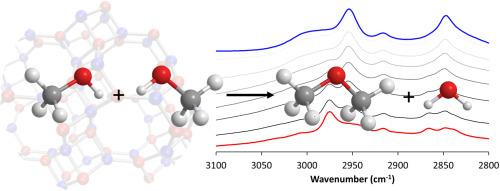利用红外光谱研究掺杂硅的磷酸铝SAPO-5、SAPO-11、SAPO-18和SAPO-34中骨架选择对酸催化二甲醚形成的重要性
IF 4.7
3区 材料科学
Q1 CHEMISTRY, APPLIED
引用次数: 0
摘要
甲醇脱水化学在很大程度上依赖于固体酸催化剂来形成各种碳氢化合物。虽然烯烃通常是在强Brønsted酸位点上形成的,但由于二甲醚具有可持续替代燃料的潜力,并且与当前的石油基础设施兼容,因此人们对二甲醚的生产越来越感兴趣。二甲醚在较长时间内的有效形成通常有利于较弱的酸位。在这里,两个甲醇分子可以偶联在一起,减少形成更大的芳香族产物,促进甲醇制烯烃过程,但也可能促进催化剂失活。在本文中,我们使用operando漫反射红外傅立叶变换光谱来探测一系列微孔硅掺杂磷酸铝(SAPO-5, SAPO-11, SAPO-18和SAPO-34)的甲醇脱水,并将研究结果与催化数据相关联,以突出有效的甲醇-二甲醚催化剂的关键参数。在这样做的过程中,我们证明了弱酸位点在二甲醚的生产中发挥关键作用,允许结合的甲氧基物种和未结合的甲醇分子共存,触发二甲醚的形成。本文章由计算机程序翻译,如有差异,请以英文原文为准。

Operando infrared spectroscopy to probe the importance of framework selection in silicon-doped aluminophosphates, SAPO-5, SAPO-11, SAPO-18, and SAPO-34, for acid catalysed dimethyl ether formation
Methanol dehydration chemistry is heavily reliant on solid acid catalysts for the formation of a wide range of hydrocarbons. Whilst olefins are routinely formed on strong Brønsted acid sites, there is a growing interest in dimethyl ether production, due to its potential as a sustainable fuel alternative, which is compatible with current petroleum infrastructure. The effective formation of dimethyl ether over extended time periods typically favours weaker acid sites. Here, two methanol molecules can couple together, reducing the formation of larger aromatic products that facilitate the methanol-to-olefin process, but which can also facilitate catalyst deactivation. In this manuscript, we use operando diffuse reflectance infrared Fourier transform spectroscopy to probe methanol dehydration on a range of microporous silicon-doped aluminophosphates (SAPO-5, SAPO-11, SAPO-18, and SAPO-34), correlating the findings with catalytic data to highlight the key parameters for an effective methanol-to-dimethyl ether catalyst. In doing so, we demonstrate that weaker acid sites play a key role in the production of dimethyl ether by permitting bound methoxy species and unbound methanol molecules to co-exist, triggering dimethyl ether formation.
求助全文
通过发布文献求助,成功后即可免费获取论文全文。
去求助
来源期刊

Microporous and Mesoporous Materials
化学-材料科学:综合
CiteScore
10.70
自引率
5.80%
发文量
649
审稿时长
26 days
期刊介绍:
Microporous and Mesoporous Materials covers novel and significant aspects of porous solids classified as either microporous (pore size up to 2 nm) or mesoporous (pore size 2 to 50 nm). The porosity should have a specific impact on the material properties or application. Typical examples are zeolites and zeolite-like materials, pillared materials, clathrasils and clathrates, carbon molecular sieves, ordered mesoporous materials, organic/inorganic porous hybrid materials, or porous metal oxides. Both natural and synthetic porous materials are within the scope of the journal.
Topics which are particularly of interest include:
All aspects of natural microporous and mesoporous solids
The synthesis of crystalline or amorphous porous materials
The physico-chemical characterization of microporous and mesoporous solids, especially spectroscopic and microscopic
The modification of microporous and mesoporous solids, for example by ion exchange or solid-state reactions
All topics related to diffusion of mobile species in the pores of microporous and mesoporous materials
Adsorption (and other separation techniques) using microporous or mesoporous adsorbents
Catalysis by microporous and mesoporous materials
Host/guest interactions
Theoretical chemistry and modelling of host/guest interactions
All topics related to the application of microporous and mesoporous materials in industrial catalysis, separation technology, environmental protection, electrochemistry, membranes, sensors, optical devices, etc.
 求助内容:
求助内容: 应助结果提醒方式:
应助结果提醒方式:


